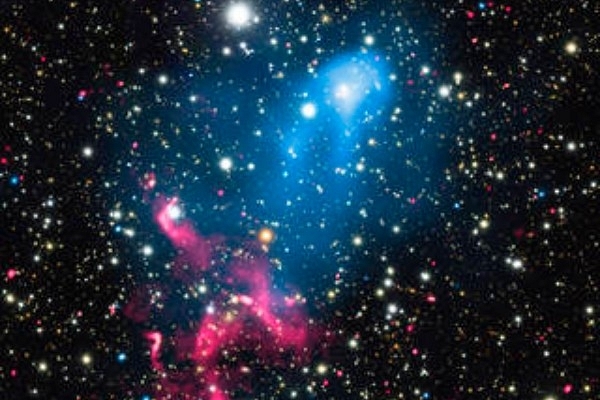Insta
Data From India’s GMRT Among Others Help Astronomers Find Cosmic Double Whammy

Abell 3411 and Abell 3412: A pair of colliding galaxies about 2 billion light years away. (X-ray: NASA/CXC/SAO/R. van Weeren et al; Optical: NAOJ/Subaru; Radio: NCRA/TIFR/GMRT)
By combining data from several telescopes around the world, including India's Giant Metrewave Radio Telescope (GMRT) in Pune, astronomers have discovered a cosmic double whammy unlike any ever seen before. Two of the most powerful phenomena in the Universe, a supermassive black hole, and the collision of giant galaxy clusters, have combined to create a stupendous cosmic particle accelerator, the researchers reported in the journal Nature Astronomy.
This cosmic double whammy is found in a pair of colliding galaxy clusters called Abell 3411 and Abell 3412 located about two billion light years from Earth. The two clusters are both very massive, each weighing about a quadrillion or a billion times the mass of the Sun. This discovery solves a long-standing mystery in galaxy cluster research about the origin of beautiful swirls of radio emission stretching for millions of light years, detected in Abell 3411 and Abell 3412 with the GMRT.
Besides GMRT, the researchers combined data from NASA's Chandra X-ray Observatory, the US National Science Foundation's Karl G. Jansky Very Large Array, and other telescopes to find out what happens when matter ejected by a giant black hole is swept up in the merger of two enormous galaxy clusters.
With inputs from IANS
Support Swarajya's 50 Ground Reports Project & Sponsor A Story
Every general election Swarajya does a 50 ground reports project.
Aimed only at serious readers and those who appreciate the nuances of political undercurrents, the project provides a sense of India's electoral landscape. As you know, these reports are produced after considerable investment of travel, time and effort on the ground.
This time too we've kicked off the project in style and have covered over 30 constituencies already. If you're someone who appreciates such work and have enjoyed our coverage please consider sponsoring a ground report for just Rs 2999 to Rs 19,999 - it goes a long way in helping us produce more quality reportage.
You can also back this project by becoming a subscriber for as little as Rs 999 - so do click on this links and choose a plan that suits you and back us.
Click below to contribute.
Latest